The SSD Update: Vertex Gets Faster, New Indilinx Drives and Intel/MacBook Problems Resolved
by Anand Lal Shimpi on March 30, 2009 12:00 AM EST- Posted in
- Storage
Real World Sanity Check
I wouldn’t dream of just relying on iometer tests to make sure that the new firmware actually made things faster - it’s far too easy to optimize for just a couple of tests. I spot checked the Vertex’s performance with the 1275 firmware using a few application launch benchmarks:
The Fresh Test is the 3-application launch benchmark I used in the original review. For those who don’t remember, I fired the testbed up and immediately upon hitting the Windows desktop I launched three applications (Photoshop CS4, Pinnacle Studio 12 and IE7). Pinnacle also had a large project to load on top of all of that. I reported the time it took to load all three applications.
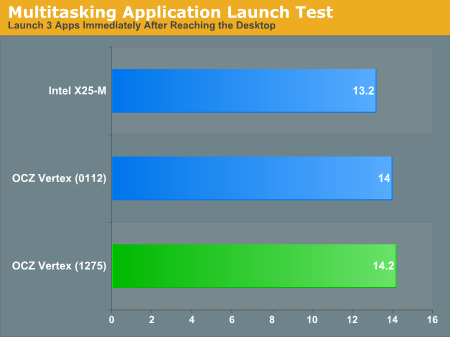
As you can see, performance is about the same between 0112 and 1275. So far, so good.
I ran a couple of application launch tests and the 1275 firmware performed similarly to the original:
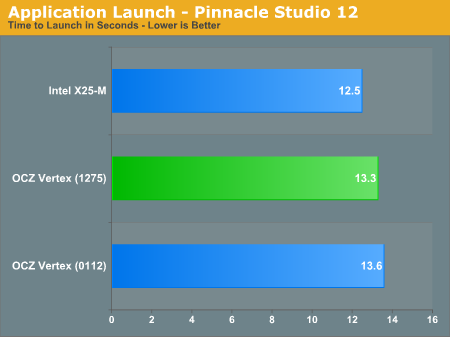
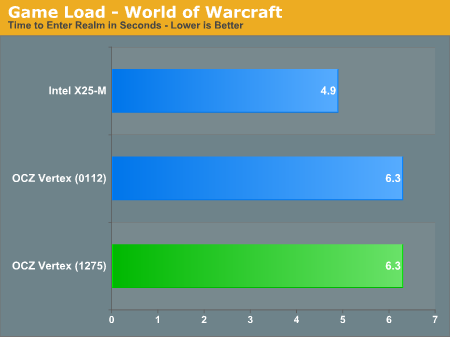
I used PCMark Vantage as another spot-check for performance. While application launch tests are mostly random read benchmarks, Vantage stresses both reads and writes - the latter showing a large improvement on the new firmware:

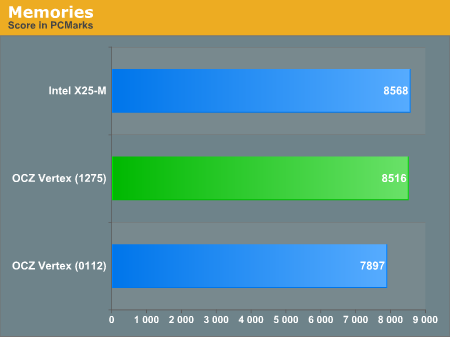
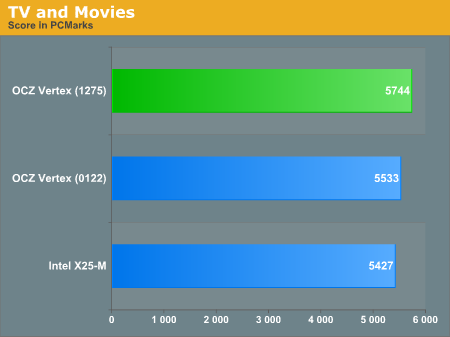
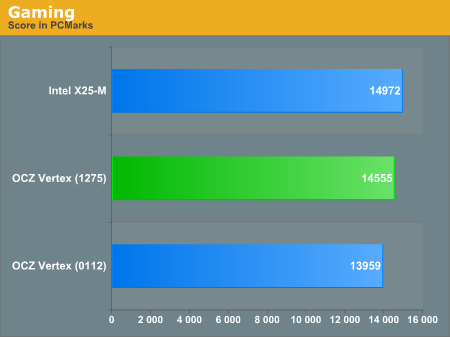
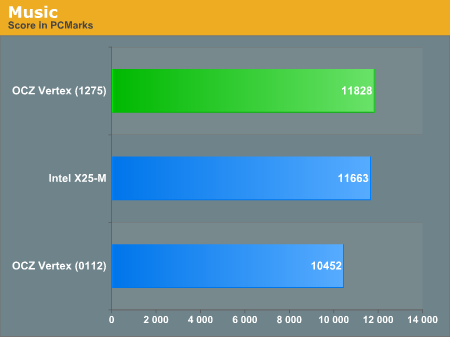

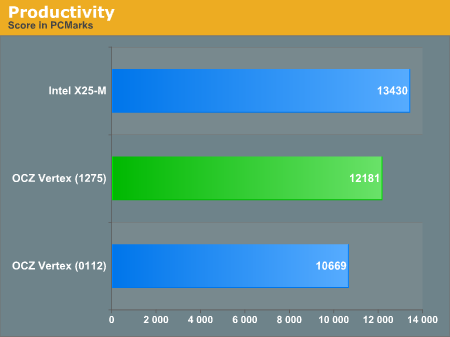
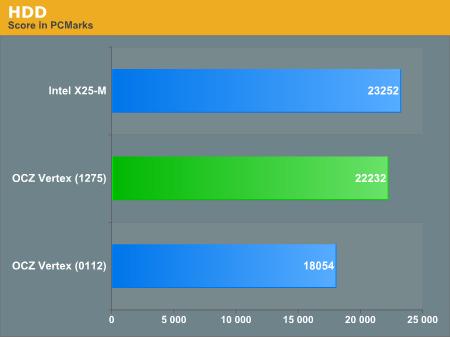
Vantage showed a close to 10% improvement in overall performance, and 23% when we’re just looking at the synthetic HDD benchmarks. Surely the performance increases are all due to the Vertex’s improved write speeds; in some scenarios the gains are large enough to be noticeable in normal use of your machine.










73 Comments
View All Comments
landheha - Saturday, July 18, 2009 - link
The risk I see in all this is putting a windows page file on such a drive that is actually used. Or an Oracle rollback tablespace or redo logfiles. These will get this kind of drive into "used-status" in no time. Not to speak of the 10.000x erase limit.As another guy said before, the difference between SLC and MLC is not to be neglected.
anactoraaron - Thursday, June 25, 2009 - link
Something I have noticed under win 7 RC x64 on my laptop is that when running on battery only the system boots up and shuts down faster than when on ac alone. I don't know why yet and this is especially revelant as even with the slightly lesser ssd's - basically non-intel - can improve laptop performance/responsiveness twofold vs. 7200rpm platter hdd's (as shown in the intial x25-m review). As far as the running on battery variable is concerned, my average shut down time on ac power is 17 seconds, and on battery it is 10 seconds (or less). Is there maybe something else going on in windows 7 that is an unknown as of now?Yes, after enjoying the initial review of the X25-M I had to spend about an hour to see where my platter hdd stood (and I'm sure I'm not the only one here that did so).
vhx - Saturday, June 13, 2009 - link
Intel X25-M or OCZ Vertex 120?The Intel seems to own it at almost everything except a few writing cases. However the theoretical 180 MB/s Write doesn't seem to show up in anything but synthetic benchmarks which STILL makes it even with the X25-M in real world performance. Not to mention the Vertex's seem to still have major performance degradations compared to X25-M's loss.
What would you all get if you had a choice?
Patanjali - Monday, May 4, 2009 - link
These seem to have a reasonable write io ops/s compared to any of those that cost less than the Intel, and they are coming cheaper all the time. They use a 2nd generation Samsung controller.When will Anandtech review them and forget about all these experiments?
Gootch - Sunday, April 19, 2009 - link
As always, my comments to your previous article should have waited until I had read the latest on these drives. However, X25 is the best (for now) and in some cases arguably cheaper/Gb. Once again a great article follow-up.steffi - Thursday, April 16, 2009 - link
So I managed to use a collegue's Intel PC at work to update the firmware in my X-25M but I've got a couple of questions ...1. Did that firmware resolve the NVidia compatibiity such that in the future I can apply the firmware update from my MacBook Pro Unibody NVidia machine?
2. Did this firmware resolve the Bootcamp issue?
3. How is it possible to use issue the SECURE_ERASE on a Mac then since it doesn't appear that HDDERASE will work given the need for legacy IDE mode?
SpeedDemonAaron - Monday, April 13, 2009 - link
Thank you so much for your honest and concise articles on SSDs lately! This is the most important hardware change that the tech world has seen in a long time. There are a lot of bits that need to be uncovered so that the public knows what they are getting themselves into. You're doing an outstanding job of protecting the consumer since manufacturers are definitely producing SSD products at the moment with no regard for the consumer!mmoran27 - Monday, April 13, 2009 - link
Here it is.Must be done on Intel system or PC
http://support.intel.com/support/ssdc/index_update...">http://support.intel.com/support/ssdc/index_update...
MadBoris - Monday, April 13, 2009 - link
PcPer did some test on the new Intel Firmware for the x25-M.Fragmentation issue went away but the drive is still to expensive. ;)
http://pcper.com/article.php?aid=691&type=expe...">http://pcper.com/article.php?aid=691&type=expe...
Eri Hyva - Saturday, April 11, 2009 - link
http://www.ocztechnology.com/products/flash_drives...">http://www.ocztechnology.com/products/f...ives/ocz...
The change log for firmware:
"
Version 0112 (Feb. 2009) (Description: Basic I/O optimized drive with SMART error logging)
• Version 1199 (Feb. 2009) (Description: Enhanced performance I/O optimized drive)
• Internal "write join" was implemented for better performance
•SMART basic features can be performed without error log monitoring
(to reduce overhead of log data collection)
•ATA power management commands (IDLE, STANDBY, SLEEP) are enabled for compatibility
(Actually these are dummy, while SATA based Power Management is fully supported)
• Supports runtime bad block handling
•Improved power management
•Improved NAND handling
•Enabled PIO mode data transfer
• Version 1275 (March, 2009) (Description: Improved raid 0 mode performance)
•Performance is improved when drive is installed on RAID0 mode host
•Maximum LBA number is modified according to the JEDEC standard
• Modifications of internal data structure used by FW (stamp)
•Improved write joining
•Improved FPDMA transfer mode
• Version 1.10 (April 7, 2009)
•Feature Add : TRIM support is added
•Apple Mac Pro sleep/wake up support added
• Updater improved
•Bad block management function improved
"